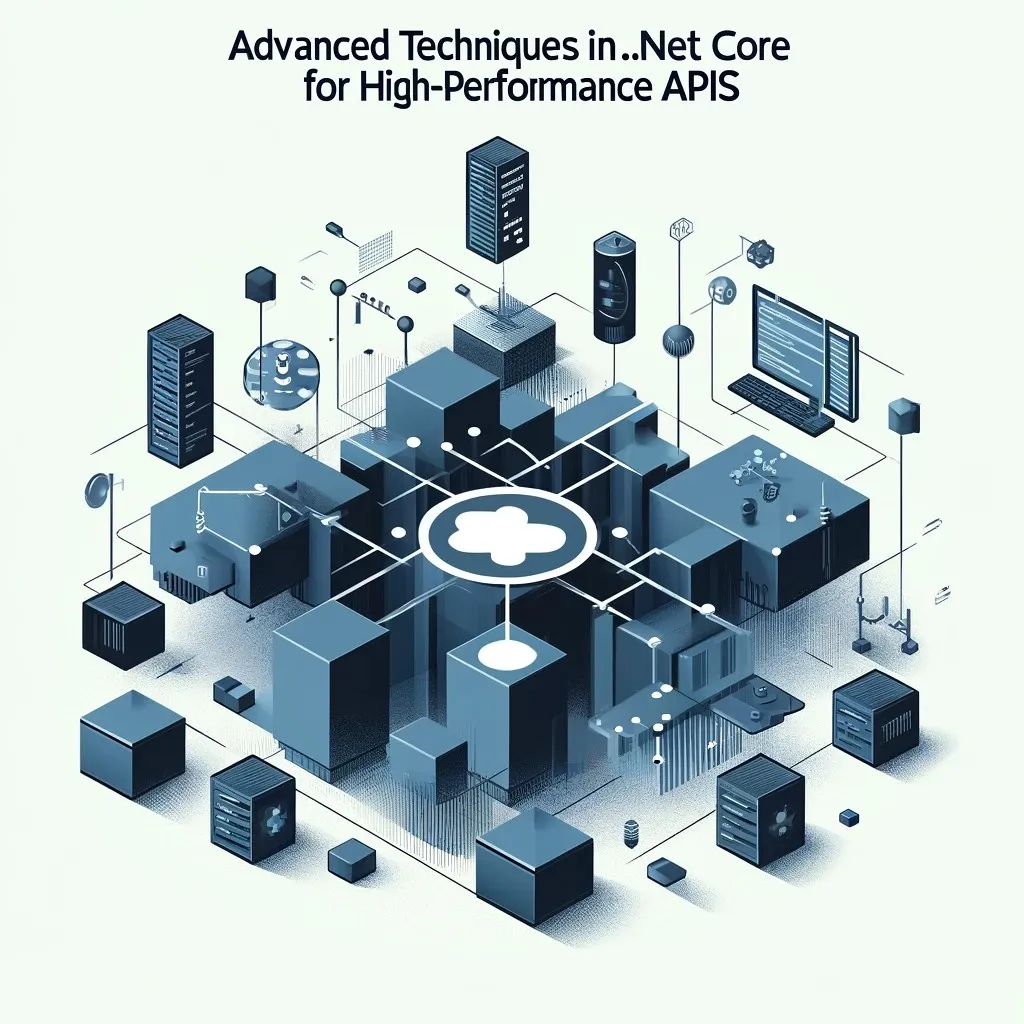在当今快速发展的技术环境中,构建高性能的API对于提供无缝的用户体验和维护可扩展的后端系统至关重要。.NET Core 提供了一个强大的框架来开发强大的API,但掌握高级技术可以使你的技能更上一层楼。在这篇文章中,我们将探讨几种高级技术,以增强你的 .NET Core API 的性能、安全性和可扩展性。
高效数据访问优化 Entity Framework Core 查询
Entity Framework Core (EF Core) 是 .NET Core 的一个强大 ORM,但低效的查询会导致性能瓶颈。这里有一些优化 EF Core 查询的技巧:
1. 为只读查询使用 AsNoTracking: 默认情况下,EF Core 会跟踪实体的变化。对于只读操作,使用 AsNoTracking 可以提高性能。
var 产品 = await _context.Products.AsNoTracking().ToListAsync();2. 避免 N+1 查询问题: 使用贪婪加载(Include)或显式加载在单个查询中获取相关数据。
var orders = await _context.Orders
.Include(o => o.OrderItems)
.ToListAsync();3. 分页: 使用 Skip 和 Take 实现高效的分页。
var pagedOrders = await _context.Orders
.Skip((pageNumber - 1) * pageSize)
.Take(pageSize)
.ToListAsync();使用Dapper进行高性能数据访问
对于性能至关重要的场景,可以考虑使用Dapper,一个轻量级的ORM。Dapper执行原始SQL查询并将结果映射到对象,相比EF Core,提供更快的性能。
使用(var connection = new SqlConnection(connectionString))
{
var sql = "SELECT * FROM Products WHERE CategoryId = @CategoryId";
var products = await connection.QueryAsync<Product>(sql, new { CategoryId = categoryId });
}利用 async/await 实现非阻塞 I/O 操作
异步编程对于构建可扩展的 API 至关重要。通过使用 async 和 await,你可以执行非阻塞 I/O 操作,从而释放线程来处理其他请求。
public async Task<IActionResult> 获取产品(int id)
{
var 产品 = await _context.Products.FindAsync(id);
if (产品 == null)
{
return NotFound();
}
return Ok(产品);
}编写高效异步代码的最佳实践
- 避免阻塞调用: 避免使用
Task.Wait()或Task.Result,因为它们会阻塞调用线程。 - 使用
ConfigureAwait(false): 在库代码中使用ConfigureAwait(false)以避免捕获同步上下文。
await SomeAsyncOperation().ConfigureAwait(false);缓存策略
使用MemoryCache实现内存缓存
内存缓存通过将频繁访问的数据存储在内存中,可以显著提高性能。
public class 产品服务类
{
private readonly IMemoryCache _cache;
public 产品服务类(IMemoryCache cache)
{
_cache = cache;
}
public Product 获取产品(int id)
{
if (!_cache.TryGetValue(id, out Product product))
{
product = _context.Products.Find(id);
if (product != null)
{
_cache.Set(id, product, TimeSpan.FromMinutes(5));
}
}
return product;
}
}使用 Redis 进行分布式缓存
对于分布式缓存,使用 Redis 在多个服务器上存储缓存数据。
public void ConfigureServices(IServiceCollection services)
{
services.AddStackExchangeRedisCache(options =>
{
options.Configuration = Configuration.GetConnectionString("RedisConnection");
options.InstanceName = "SampleInstance";
});
}API 安全
实现JWT认证
JWT(JSON Web Token)是一种流行的保护API的安全方法。它允许无状态认证,即服务器在不存储会话数据的情况下验证令牌的有效性。
public void ConfigureServices(IServiceCollection services)
{
services.AddAuthentication(JwtBearerDefaults.AuthenticationScheme)
.AddJwtBearer(options =>
{
options.TokenValidationParameters = new TokenValidationParameters
{
ValidateIssuer = true,
ValidateAudience = true,
ValidateLifetime = true,
ValidateIssuerSigningKey = true,
ValidIssuer = Configuration["Jwt:Issuer"],
ValidAudience = Configuration["Jwt:Issuer"],
IssuerSigningKey = new SymmetricSecurityKey(Encoding.UTF8.GetBytes(Configuration["Jwt:Key"]))
};
});
}使用OAuth2和OpenID Connect保护API
OAuth2和OpenID Connect提供了保护API和管理用户身份的强大框架。
public void ConfigureServices(IServiceCollection services)
{
services.AddAuthentication(options =>
{
options.DefaultScheme = "Cookies";
options.DefaultChallengeScheme = "oidc";
})
.AddCookie("Cookies")
.AddOpenIdConnect("oidc", options =>
{
options.Authority = "https://your-identity-server";
options.ClientId = "client-id";
options.ClientSecret = "client-secret";
options.ResponseType = "code";
options.SaveTokens = true;
});
}性能监控和诊断
使用 Application Insights 进行监控
Application Insights 提供了强大的工具来监控您的应用,诊断问题,并深入了解性能。
public void ConfigureServices(IServiceCollection services)
{
services.AddApplicationInsightsTelemetry(Configuration["ApplicationInsights:InstrumentationKey"]);
}使用 .NET Core 诊断工具进行性能分析
使用 .NET Core 内置的诊断工具,如 dotnet-counters 和 dotnet-trace 命令行工具,来分析和优化应用程序的性能。
扩展和负载均衡
使用 Kubernetes 和 Docker 进行水平扩展
使用 Docker 容器部署 .NET Core 应用程序,并使用 Kubernetes 在多个节点上进行编排和扩展。
apiVersion: apps/v1
kind: Deployment
metadata:
name: my-api
spec:
replicas: 3
template:
spec:
containers:
- name: my-api
image: my-api-image:latest使用NGINX和Azure Load Balancer的负载均衡策略
使用NGINX或Azure Load Balancer将流量分配到应用程序的多个实例,确保高可用性和可靠性。
限流和节流
实现速率限制以保护API
使用ASP.NET Core Middleware实现速率限制,保护您的API免受滥用,并确保公平使用。
public void ConfigureServices(IServiceCollection services)
{
services.AddRateLimiter(options =>
{
options.AddFixedWindowLimiter("fixed", limiterOptions =>
{
limiterOptions.PermitLimit = 100;
limiterOptions.Window = TimeSpan.FromMinutes(1);
limiterOptions.QueueProcessingOrder = QueueProcessingOrder.OldestFirst;
limiterOptions.QueueLimit = 2;
});
});
}使用ASP.NET Core中间件进行限流
实现限流以管理并发请求数量并防止服务器过载。
public class ThrottlingMiddleware
{
private readonly RequestDelegate _next;
public ThrottlingMiddleware(RequestDelegate next)
{
_next = next;
}
public async Task InvokeAsync(HttpContext context)
{
// 限流逻辑在此处实现
await _next(context);
}
}结论
在 .NET Core 中构建高性能的 API 涉及到高效的数据访问、异步编程、缓存、安全、性能监控、扩展性和速率限制等高级技术。通过实现这些最佳实践,你可以确保你的 API 坚固、可扩展且安全,为用户提供无缝的体验。拥抱这些高级技术,提升你的 .NET Core 后端开发技能,构建在竞争激烈的科技领域中脱颖而出的 API。
共同学习,写下你的评论
评论加载中...
作者其他优质文章






